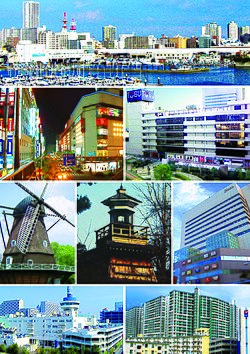Funabashi(Thuyền kiều thị,Funabashi-shi)is acitylocated inChiba Prefecture,Japan.As of 1 December 2020[update],the city had an estimatedpopulationof 644,668 in 309,238 households and apopulation densityof 7,500 inhabitants per square kilometre (19,000/sq mi).[1]The total area of the city is 85.62 square kilometres (33.06 sq mi). It is theGreater Tokyo Area's 7th most populated city (after passingKawaguchi,HachiojiandChiba), and second largest in Chiba Prefecture.
Funabashi
Thuyền kiều thị | |||||||||||||||||||||||||
|---|---|---|---|---|---|---|---|---|---|---|---|---|---|---|---|---|---|---|---|---|---|---|---|---|---|

| |||||||||||||||||||||||||
 Location of Funabashi in Chiba Prefecture] | |||||||||||||||||||||||||
 | |||||||||||||||||||||||||
| Coordinates:35°41′40.4″N139°58′57.2″E/ 35.694556°N 139.982556°E | |||||||||||||||||||||||||
| Country | Japan | ||||||||||||||||||||||||
| Region | Kantō | ||||||||||||||||||||||||
| Prefecture | Chiba | ||||||||||||||||||||||||
| First official recorded | 110 AD | ||||||||||||||||||||||||
| City Settled | April 1, 1937 | ||||||||||||||||||||||||
| Government | |||||||||||||||||||||||||
| • Mayor | Toru Matsudo | ||||||||||||||||||||||||
| Area | |||||||||||||||||||||||||
• Total | 85.62 km2(33.06 sq mi) | ||||||||||||||||||||||||
| Population (December 1, 2020) | |||||||||||||||||||||||||
• Total | 644,668 | ||||||||||||||||||||||||
| • Density | 7,500/km2(20,000/sq mi) | ||||||||||||||||||||||||
| Time zone | UTC+9(Japan Standard Time) | ||||||||||||||||||||||||
| Postal code(s) | 273 or 274 | ||||||||||||||||||||||||
| Area code | 047-4 | ||||||||||||||||||||||||
| Phone number | 047-436-2111 | ||||||||||||||||||||||||
| Address | 2-10-25 Minato-cho, Funabashi-shi, 273-8501 | ||||||||||||||||||||||||
| Climate | Cfa | ||||||||||||||||||||||||
| Website | Official website | ||||||||||||||||||||||||
| Symbols | |||||||||||||||||||||||||
| Flower | Camellia sasanqua | ||||||||||||||||||||||||
| Tree | Camellia sasanqua | ||||||||||||||||||||||||

Geography
editFunabashi is located in northwestern Chiba Prefecture approximately 20 kilometers in either direction from the prefectural capital atChibaand downtown Tokyo. The central area forms a flat diluvial upland of theShimōsa Plateau.The city sits at an elevation of 20 to 30 meters above sea level, and is relatively flat. The highest point is 32.3 meters in Narashino 3-chome, and the lowest point is 0.2 meters in Minatomachi 1-chome. Funabashi is crossed by theTone River,and the smallEbi Riveris located entirely within city limits. Funabashi formerly had wide, shallow beaches, but much of the coast has been industrialized and transformed byreclaimed land.The city extends for 13.86 kilometers east–west and 14.95 kilometers north–south.
Neighboring municipalities
editChiba Prefecture
Climate
editFunabashi has ahumid subtropical climate(KöppenCfa) characterized by warm summers and cool winters with light to no snowfall. The average annual temperature in Funabashi is 15.5 °C (59.9 °F). The average annual rainfall is 1,466.1 mm (57.72 in) with October as the wettest month. The temperatures are highest on average in August, at around 26.8 °C (80.2 °F), and lowest in January, at around 4.8 °C (40.6 °F).[2]
| Climate data for Funabashi (1999−2020 normals, extremes 1999−present) | |||||||||||||
|---|---|---|---|---|---|---|---|---|---|---|---|---|---|
| Month | Jan | Feb | Mar | Apr | May | Jun | Jul | Aug | Sep | Oct | Nov | Dec | Year |
| Record high °C (°F) | 18.6 (65.5) |
24.7 (76.5) |
24.5 (76.1) |
27.1 (80.8) |
33.2 (91.8) |
34.8 (94.6) |
38.0 (100.4) |
39.0 (102.2) |
35.9 (96.6) |
32.2 (90.0) |
25.2 (77.4) |
23.5 (74.3) |
39.0 (102.2) |
| Mean daily maximum °C (°F) | 9.5 (49.1) |
10.3 (50.5) |
13.8 (56.8) |
18.7 (65.7) |
23.1 (73.6) |
25.9 (78.6) |
29.7 (85.5) |
31.3 (88.3) |
27.5 (81.5) |
21.9 (71.4) |
16.7 (62.1) |
11.7 (53.1) |
20.0 (68.0) |
| Daily mean °C (°F) | 4.8 (40.6) |
5.7 (42.3) |
9.0 (48.2) |
13.8 (56.8) |
18.5 (65.3) |
21.6 (70.9) |
25.4 (77.7) |
26.8 (80.2) |
23.4 (74.1) |
17.8 (64.0) |
12.2 (54.0) |
7.1 (44.8) |
15.5 (59.9) |
| Mean daily minimum °C (°F) | 0.4 (32.7) |
1.4 (34.5) |
4.4 (39.9) |
9.3 (48.7) |
14.5 (58.1) |
18.4 (65.1) |
22.4 (72.3) |
23.7 (74.7) |
20.2 (68.4) |
14.3 (57.7) |
8.2 (46.8) |
2.8 (37.0) |
11.7 (53.0) |
| Record low °C (°F) | −5.4 (22.3) |
−4.7 (23.5) |
−2.0 (28.4) |
−0.6 (30.9) |
7.4 (45.3) |
10.7 (51.3) |
15.7 (60.3) |
16.6 (61.9) |
9.5 (49.1) |
6.0 (42.8) |
−1.1 (30.0) |
−3.6 (25.5) |
−5.4 (22.3) |
| Averageprecipitationmm (inches) | 63.0 (2.48) |
61.4 (2.42) |
103.0 (4.06) |
114.5 (4.51) |
129.8 (5.11) |
155.3 (6.11) |
121.9 (4.80) |
111.4 (4.39) |
189.7 (7.47) |
239.9 (9.44) |
97.4 (3.83) |
63.3 (2.49) |
1,466.1 (57.72) |
| Average precipitation days(≥ 1.0 mm) | 4.9 | 6.2 | 9.5 | 10.0 | 10.2 | 11.7 | 9.8 | 7.8 | 10.9 | 10.9 | 8.4 | 5.9 | 106.2 |
| Mean monthlysunshine hours | 192.0 | 166.0 | 182.8 | 185.3 | 185.3 | 128.0 | 162.6 | 194.1 | 143.8 | 137.7 | 145.9 | 177.3 | 1,999.9 |
| Source:Japan Meteorological Agency[3][2] | |||||||||||||
Demographics
editPer Japanese census data,[4]the population of Funabashi has increased rapidly over the past century.
| Year | Pop. | ±% |
|---|---|---|
| 1920 | 34,119 | — |
| 1930 | 46,644 | +36.7% |
| 1940 | 61,624 | +32.1% |
| 1950 | 100,134 | +62.5% |
| 1960 | 135,038 | +34.9% |
| 1970 | 325,426 | +141.0% |
| 1980 | 497,439 | +52.9% |
| 1990 | 533,270 | +7.2% |
| 2000 | 550,074 | +3.2% |
| 2010 | 609,040 | +10.7% |
| 2020 | 642,907 | +5.6% |
History
editThe name "Funabashi" is mentioned in theKamakura periodchronicleAzuma Kagami.However, the name itself is even more ancient, dating from before theNara periodand theYamatotakerumythology. Archaeologists have found stone tools from theJapanese Paleolithicperiod andshell middensfrom theJōmon periodin the area, indicating continuous inhabitation for thousands of years. A number ofShinto shrinesandBuddhist templesin the area claim to have been founded in theNara periodorHeian period.During theMuromachi periods,the area was controlled by theChiba clan.During theSengoku period,the Chiba clan fought theSatomi clanto the south, and theLate Hōjō clanto the west. After the defeat of the Chiba clan, the area came within the control ofTokugawa Ieyasu.[citation needed]
Under theTokugawa shogunate,the area prospered as apost townon the river crossing of theTone River,and was largely retained astenryōunder the direct control of the Shogunate and administered through a number ofhatamoto.The area was also a favored hunting grounds for the Shōgun. During theBoshin Warof theMeiji Restoration,Funabashi was the location of a minor skirmish between Tokugawa loyalists underEnomoto Takeakiand the pro-Imperial forces ofOkayama DomainandSatsuma Domain,during which most of the town burned down.[citation needed]
After theabolition of the han system,the area eventually became part of Chiba Prefecture. Funabashi Town was one of several towns and villages created on April 1, 1889, underInba Districtwith the establishment of the modern municipalities system. The area developed rapidly due to its proximity to Tokyo and the presence of numerous military facilities in the area. On April 1, 1937, Funabashi was elevated to city status through merger with neighboring Katsushika Town and Yasakae, Hoden and Tsukada Villages. The new city was host to numerous military installations in World War II, and was bombed in theair raids on Japanin 1945.[citation needed]
The city developed rapidly in the postwar period, with the development of industries, public housing developments and port facilities. With the annexation of neighboring Ninomiya Town in 1953, the population exceeded 100,000. The population exceeded 300,000 in 1969 and 500,000 in 1982. Funabashi was designated acore cityon April 1, 2005, with increased local autonomy from the central government. The population exceeded 600,000 in 2006.[citation needed]
Government
editFunabashi has amayor-councilform of government with a directly elected mayor and aunicameralcity council of 50 members. Funabashi contributes seven members to the Chiba Prefectural Assembly. In terms of national politics, the city is divided between theChiba 4th districtand theChiba 14th districtof thelower houseof theDiet of Japan.
Economy
editFunabashi is a regional commercial center and, due to its numerous train connections, abedroom communityfor nearby Chiba and Tokyo. Approximately 34.5% of the working population commutes to Tokyo, per the 2015 census.
Companies from Funabashi
edit- Mugen Seiki- a remote control car manufacturer
Education
edit- Nihon Universitybranch campus
- Funabashi has 54 public elementary schools and 27 public middle schools operated by the city government, and 11 public high schools operated by the Chiba Prefectural Board of Education. There are also one private elementary school, one private middle school and four private high schools. The prefecture also operates one special education school for the handicapped.
Transportation
editRailway
editKeisei Electric Railway-Keisei Main Line
- Keisei Nakayama-Higashi-Nakayama-Keisei-Nishifuna-Kaijin-Keisei Funabashi-Daijingūshita-Funabashi-Keibajō
Shin-Keisei Electric Railway-Shin-Keisei Line
Tōyō Rapid Railway-Tōyō Rapid Line
Highway
editSister cities
editLocal attractions
editNotable structures
edit- Funabashi Racecourse
- Funabashi Sports Park Arena,playground of theChiba Jets
- Nakayama Racecourse
- LaLaPort shopping mall, one of the largest in Japan
- SSAWSindoor ski slope (closed and demolished in 2003)
- Japan's first large-formatIKEAstore, built on the site of SSAWS
Notable places
editNotable people from Funabashi
edit- Hiroki Aiba,dancer and singer
- Kazuyuki Fujita,professional wrestler
- Funassyi,unofficial city mascot
- Arisa Hoshiki,Former professional wrestler, singer under the alter ego Udon Sato
- Sayaka Ichii,musician
- Atsushi Itō,actor
- Yuko Kavaguti,figure skater
- Mai Kuraki,singer
- Fumie Kurotori,swimmer
- Minori Matsushima,voice Actress
- Mai Minokoshi,professional tennis player
- Manabu Namiki,video game designer
- Yoshihiro Natsuka,professional soccer player
- Katsuhiko Nishijima,Anime director
- Michiko Nishiwaki,actress, stunt woman
- Yoshihiko Noda,politician, formerPrime Minister of Japan
- Hanako Oku,musician
- Toru Oniki,professional soccer manager and former player
- Shunzo Ono,professional soccer player
- Manabu Orido,racing driver
- Tamao Satō,actress
- Takashi Sekizuka,professional soccer player
- Mariko Shiga,musician
- Rin Takanashi,film and television actress
- Keiko Terada,singer (Show-Ya)
- Akeno Watanabe,voice actress
- Azusa Yamamoto,gravure idol
- Tomohisa Yamashita,musician
- Risa Yoshiki,model, actress, singer
Eponym
edit- In 2018, asteroid25892 Funabashiwas named for the city
References
edit- ^"Funabashi city official statistics"(in Japanese). Japan.
- ^abKhí tượng sảnh / năm thường trị ( năm ・ nguyệt ごと の trị ).JMA.RetrievedApril 3,2022.
- ^Quan trắc sử thượng 1~10 vị の trị ( trong năm を thông じて の trị ).JMA.RetrievedApril 3,2022.
- ^Funabashi population statistics
- ^ab"International Exchange".List of Affiliation Partners within Prefectures.Council of Local Authorities for International Relations (CLAIR). Archived fromthe originalon 4 March 2016.Retrieved21 November2015.
External links
edit- Funabashitravel guide from Wikivoyage
- Official Website(in Japanese)


